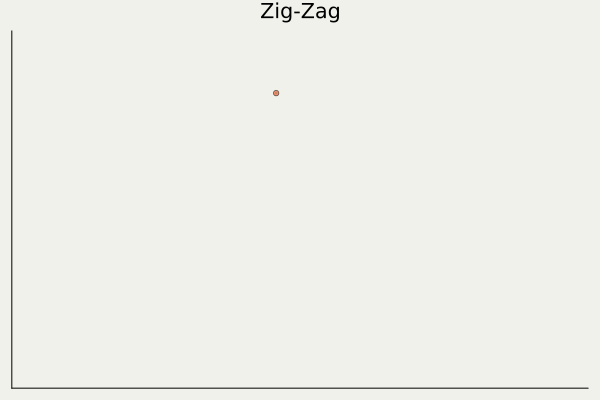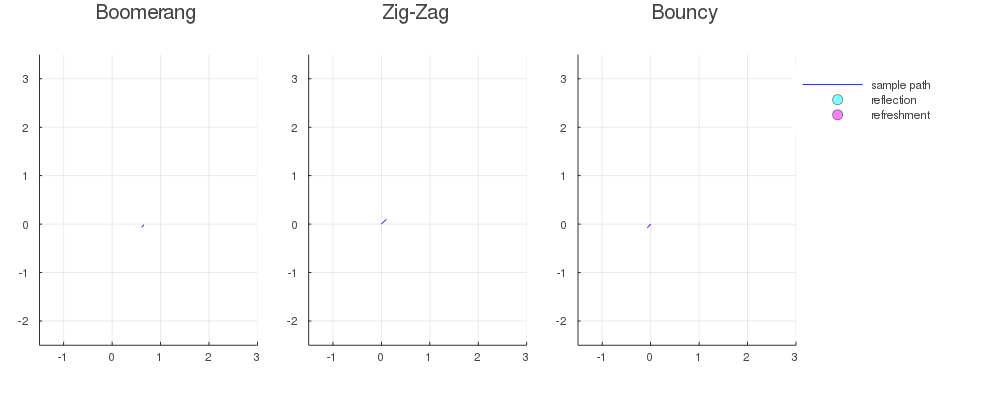1 The Zig-Zag Sampler: What Is It?
A continuous-time variant of MCMC algorithms

A Blog Entry on Bayesian Computation by an Applied Mathematician
$$
$$
1.1 Keywords: PDMP (1/2)
PDMP (Piecewise Deterministic1 Markov Process2) (Davis, 1984)
- Mostly deterministic with the exception of random jumps happens at random times
- Continuous-time, instead of discrete-time processes
Plays a complementary role to SDEs / Diffusions
| Property | PDMP | SDE |
|---|---|---|
| Exactly simulatable? | ||
| Subject to discretization errors? | ||
| Driving noise | Poisson | Gauss |
- First applications: control theory, operations research, etc. (Davis, 1993)
- Second applications: Monte Carlo simulation in material sciences (Peters and de With, 2012)
- Third applications: Bayesian statistics (Bouchard-Cote+2018-BPS?)
1.2 Keywords: PDMP (2/2)
- We will concentrate on Zig-Zag sampler (Bierkens, Fearnhead, et al., 2019)
- Other PDMPs: Bouncy sampler (Bouchard-Cote+2018-BPS?) , Boomerang sampler (Bierkens et al., 2020)

1.4 Review: Metropolis-Hastings (1/2)
MH algorithm works even without p’s normalizing constant. Hence, its ubiquity.
1.5 Review: Metropolis-Hastings (2/2)
Alternative View: MH is a generic procedure to turn a simple q-Markov chain into a Markov chain converging to p.
1.6 Problem: Reversibility
Reversibility (a.k.a detailed balance): p(x)q(x|y)=p(y)q(y|x). In words: \text{Probability}[\text{Going}\;x\to y]=\text{Probability}[\text{Going}\;y\to x]. Harder to explore the entire space
Slow mixing of MH
From the beginning of 21th century, many efforts have been made to make MH irreversible.
1.7 Lifting (1/3)
Lifting: A method to make MH’s dynamics irreversible
How?: By adding an auxiliary variable \sigma\in\{\pm1\}, called momentum
1.8 Lifting (2/3)
q^{(+1)}: Only propose \rightarrow moves
q^{(-1)}: Only propose \leftarrow moves
Once going uphill, it continues to go uphill.
This is irreversible, since
\begin{align*} &\text{Probability}[x\to y]\\ &\qquad\ne\text{Probability}[y\to x]. \end{align*}
1.9 Lifting (3/3)
Reversible dynamic of MH has ‘irreversified’
Scale is different in the vertical axis!
Lifted MH successfully explores the edges of the target distribution.
*Irreversibility actually improves the efficiency of MCMC, as we observe in two slides later.
1.10 Comparison: MH vs. LMH vs. Zig-Zag (1/2)
Zig-Zag corresponds to the limiting case of lifted MH as the step size of proposal q goes to zero, as we’ll learn later.
Zig-Zag has a maximum irreversibility.
1.11 Comparison: MH vs. LMH vs. Zig-Zag (2/2)
Irreversibility actually improves the efficiency of MCMC.
Faster decay of autocorrelation \rho_t\approx\mathrm{Corr}[X_0,X_t] implies
- faster mixing of MCMC
- lower variance of Monte Carlo estimates
1.12 Review: MALA
Two MCMC algorithms derived from Langevin diffusion:
ULA (Unadjusted Langevin Algorithm)
\quad Use the discretization of (X_t). Discretization errors accumulate.
MALA (Metropolis Adjusted Langevin Algorithm)
\quad Use ULA as a proposal in MH, erasing the errors by MH steps.
1.13 Comparison: Zig-Zag vs. MALA (1/3)
How fast do they go back to high-probability regions? 4
Irreversibility of Zig-Zag accelerates its convergence.
1.14 Comparison: Zig-Zag vs. MALA (2/3)
The left plot looks continuous, but it actually is not.
MH, including MALA, is actually a discrete-time process.
The plot is obtained by connecting the points by line segments.
1.15 Comparison: Zig-Zag vs. MALA (3/3)
Monte Carlo estimation is also done differently:
MALA outputs (X_n)_{n\in[N]} defines
\frac{1}{N}\sum_{n=1}^Nf(X_n)\xrightarrow{N\to\infty}\int_{\mathbb{R}^d} f(x)p(x)\,dx.
Zig-Zag outputs (X_t)_{t\in[0,T]} defines
\int^T_0f(X_t)\,dt\xrightarrow{T\to\infty}\int_{\mathbb{R}^d} f(x)p(x)\,dx.
1.16 Recap of Section 1
- Zig-Zag Sampler’s trajectory is a PDMP.
- PDMP, by design, has maximum irreversibility.
- Irreversibility leads to faster convergence of Zig-Zag in comparisons against MH, Lifted MH, and especially MALA.
2 The Algorithm: How to Use It?
Fast and exact simulation of continuous trajectory.
2.1 Review: MH vs. LMH vs. Zig-Zag (1/2)
As we’ve learned before, Zig-Zag corresponds to the limiting case of lifted MH as the step size of proposal q goes to zero.
2.2 Review: MH vs. LMH vs. Zig-Zag (2/2)
‘Limiting case of lifted MH’ means that we only simulate where we should flip the momentum \sigma\in\{\pm1\} in Lifted MH.
2.3 Algorithm (1/2)
‘Limiting case of lifted MH’ means that we only simulate where we should flip the momentum \sigma\in\{\pm1\} in Lifted MH.
2.4 Algorithm (2/2)
Its ergodicity is ensured as long as there exists c,C>0 such that6 p(x)\le C\lvert x\rvert^{-c}.
2.5 Core of the Algorithm
Given a rate function \lambda(x,\sigma):=\biggr(\sigma U'(x)\biggl)_++\;\gamma(x) how to simulate a corresponding Poisson point process?
2.6 Simulating Poisson Point Process (1/2)
When \displaystyle\lambda(x,\sigma)\equiv c\;(\text{constant}),
blue line: Poisson Process
red dots: Poisson Point Process
satisfying \displaystyle\textcolor{#0096FF}{N_t}=\textcolor{#E95420}{N([0,t])}\sim\mathrm{Pois}(ct).
2.7 Simulating Poisson Point Process (2/2)
Since \displaystyle\lambda(x,\sigma):=\biggr(\sigma U'(x)\biggl)_++\;\gamma(x), M can be quite complicated.
Inverting M can be impossible.
We need more general techniques: Poisson Thinning.
2.8 Poisson Thinning (1/2)
m(t): Defined via \displaystyle\lambda(x,\sigma):=\biggr(\sigma U'(x)\biggl)_++\;\gamma(x).
M(t): Simple upper bound m\le M, such that M^{-1} is analytically tractable.
2.9 Poisson Thinning (2/2)
In order to simulate a Poisson Point Process with rate \lambda(x,\sigma):=\biggr(\sigma U'(x)\biggl)_++\;\gamma(x), we find a invertible upper bound M that satisfies \int^t_0\lambda(x_s,\sigma_s)\,ds=m(t)\le\textcolor{#0096FF}{M}(t). for all possible Zig-Zag trajectories \{(x_s,\sigma_s)\}_{s\in[0,T]}.
2.10 Recap of Section 2
- Continuous-time MCMC, based on PDMP, has an entirely different algorithm and strategy.
- To simulate PDMP is to simulate Poisson Point Process.
- The core technology to simulate Poisson Point Process is Poisson Thinning.
- Poisson Thinning is about finding an upper bound M, with tractable inverse M^{-1}; Typically a polynomial function.
- The upper bound M has to be given on a case-by-case basis.
3 Proof of Concept: How Good Is It?
Quick demonstration of the state-of-the-art performance on a toy example.
3.1 Review: The 3 Steps of Zig-Zag Sampling
Given a target p,
- Calculate the negative log-likelihood U(x):=-\log p(x)
- Fix a refresh rate \gamma(x) and compute the rate function \lambda(x,\sigma):=\biggr(\sigma U'(x)\biggl)_++\;\gamma(x).
- Find an invertible upper bound M that satisfies \int^t_0\lambda(x_s,\sigma_s)\,ds=:m(t)\le\textcolor{#0096FF}{M}(t).
3.2 Model: 1d Gaussian Mean Reconstruction
The negative log-likelihood: \begin{align*} U(x)&=-\log p(x)\\ &=\frac{x^2}{2\rho^2}+\frac{1}{2\sigma^2}\sum_{i=1}^n(x-y_i)^2+\mathrm{const.},\\ U'(x)&=\frac{x}{\rho^2}+\frac{1}{\sigma^2}\sum_{i=1}^n(x-y_i),\\ U''(x)&=\frac{1}{\rho^2}+\frac{n}{\sigma^2}. \end{align*}
3.4 Simple Zig-Zag Sampler with \gamma\equiv0 (1/2)
Fixing \gamma\equiv0, we obtain the upper bound M \begin{align*} m(t)&=\int^t_0\lambda(x_s,\sigma_s)\,ds=\int^t_0\biggr(\sigma U'(x_s)\biggl)_+\,ds\\ &\le\left(\frac{\sigma x}{\rho^2}+\frac{\sigma}{\sigma^2}\sum_{i=1}^n(x-y_i)+t\left(\frac{1}{\rho^2}+\frac{n}{\sigma^2}\right)\right)_+\\ &=:(a+bt)_+=\textcolor{#0096FF}{M}(t), \end{align*}
where a=\frac{\sigma x}{\rho^2}+\frac{\sigma}{\sigma^2}\sum_{i=1}^n(x-y_i),\quad b=\frac{1}{\rho^2}+\frac{n}{\sigma^2}.
3.5 Result: 1d Gaussian Mean Reconstruction
We generated 100 samples from \mathrm{N}(x_0,\sigma^2) with x_0=1.
3.6 MSE per Epoch: The Vertical Axis
MSE (Mean Squared Error) of \{X_i\}_{i=1}^n is defined as \frac{1}{n}\sum_{i=1}^n(X_i-x_0)^2. Epoch: Unit computational cost.
3.7 Good News!
Case-by-case construction of an upper bound M is too complicated / demanding.
Therefore, we are trying to automate the whole procedure.
References
Appendix: Scalability by Subsampling
Construction of ZZ-CV (Zig-Zag with Control Variates).
3.8 Review: 1d Gaussian Mean Reconstruction
U' has an alternative form:
\begin{align*} U'(x)&=\frac{x}{\rho^2}+\frac{1}{\sigma^2}\sum_{i=1}^n(x-y_i)=:\frac{1}{n}\sum_{i=1}^nU'_i(x), \end{align*} where U'_i(x)=\frac{x}{\rho^2}+\frac{n}{\sigma^2}(x-y_i).
We only need one sample y_i to evaluate U'_i.
3.9 Randomized Rate Function
Instead of \lambda_{\textcolor{#78C2AD}{\text{ZZ}}}(x,\sigma)=\biggr(\sigma U'(x)\biggl)_+ we use \lambda_{\textcolor{#E95420}{\text{ZZ-CV}}}(x,\sigma)=\biggr(\sigma U'_I(x)\biggl)_+,\qquad I\sim\mathrm{U}([n]). Then, the latter is an unbiased estimator of the former: \operatorname{E}_{I\sim\mathrm{U}([n])}\biggl[\lambda_{\textcolor{#E95420}{\text{ZZ-CV}}}(x,\sigma)\biggr]=\lambda_{\textcolor{#78C2AD}{\text{ZZ}}}(x,\sigma).
3.10 Last Step: Poisson Thinning
Find an invertible upper bound M that satisfies \int^t_0\lambda_{\textcolor{#E95420}{\text{ZZ-CV}}}(x_s,\sigma_s)\,ds=:m_I(t)\le\textcolor{#0096FF}{M}(t),\qquad I\sim\mathrm{U}([n]). It is harder to bound \lambda_{\textcolor{#E95420}{\text{ZZ-CV}}}, since it is now an estimator (random function).
3.11 Upper Bound M with Control Variates
Then, with a re-parameterization of m_i, m_i(t)\le M(t):=a+bt,
where a=(\sigma U'(x_*))_++\|U'\|_\mathrm{Lip}\|x-x_*\|_p,\qquad b:=\|U'\|_\mathrm{Lip}. And m_i is redefined as m_i(t)=U'(x_*)+U'_i(x)-U'_i(x_*).
3.12 Subsampling with Control Variates
Zig-Zag sampler with the random rate function \lambda_{\textcolor{#E95420}{\text{ZZ-CV}}}(x,\sigma)=\biggr(\sigma U'_I(x)\biggl)_+,\qquad I\sim\mathrm{U}([n]). and the upper bound M(t)=a+bt is called Zig-Zag with Control Variates (Bierkens, Fearnhead, et al., 2019).
3.13 Zig-Zag with Control Variates
- has O(1) efficiency as the sample size n grows.7
- is exact (no bias).
3.14 Scalability (1/3)
There are currently two main approaches to scaling up MCMC for large data.
Devide-and-conquer
Devide the data into smaller chunks and run MCMC on each chunk.
Subsampling
Use a subsampling estimate of the likelihood, which does not require the entire data.
3.15 Scalability (2/3) by Devide-and-conquer
Devide the data into smaller chunks and run MCMC on each chunk.
| Unbiased? | Method | Reference |
|---|---|---|
| WASP | (Srivastava et al., 2015) | |
| Consensus Monte Carlo | (Scott et al., 2016) | |
| Monte Carlo Fusion | (Dai et al., 2019) |
3.16 Scalability (3/3) by Subsampling
Use a subsampling estimate of the likelihood, which does not require the entire data.
| Unbiased? | Method | Reference |
|---|---|---|
| Stochastic Gadient MCMC | (Welling and Teh, 2011) | |
| Zig-Zag with Subsampling | (Bierkens, Fearnhead, et al., 2019) | |
| Stochastic Gradient PDMP | (Fearnhead et al., 2024) |
Footnotes
Mostly deterministic with the exception of random jumps happens at random times↩︎
Continuous-time, instead of discrete-time processes↩︎
under fairly general conditions on p.↩︎
The target here is the standard Cauchy distribution \mathrm{C}(0,1), equivalent to \mathrm{t}(1) distribution. Its heavy tails hinder the convergence of MCMC.↩︎
Multidimensional extension is straightforward, but we won’t cover it today.↩︎
With some regularity conditions on U. (See Bierkens, Roberts, et al., 2019).↩︎
As long as the preprocessing step is properly done.↩︎